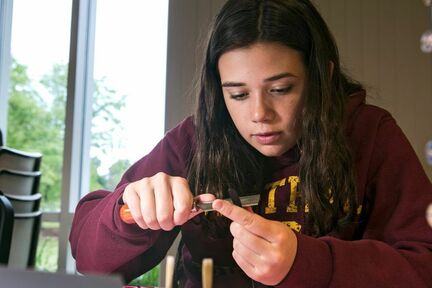When can my oboist learn how to make their own reeds?
 Oboist making reeds at the 2018 CMU Oboe Reed Making Camp
Oboist making reeds at the 2018 CMU Oboe Reed Making Camp
Most young oboists only learn how to make reeds if they are taking lessons with an oboist who can teach them the process. It is best to follow the advice of their oboe teacher, who will know when it is time for your oboist to start learning about reed making (usually when the oboist has a stable embouchure, great air support, excellent intonation, and a good quality intermediate or professional model oboe). Oboe teachers typically start teaching their students to make reeds in high school. It is not uncommon, however, for an oboist to start learning how to make reeds during their college freshman year as a music major/minor.
Reed making is a serious financial investment. The initial investment for tools, oboe cane, and other supplies will likely run between $130-$150.
It is also a serious time commitment. In addition to practice time, the oboist will need to find time in their daily schedule to "practice" reed making. Regular tying, scraping, and crowing is critically important as they begin learning this skill. If your oboist is already involved in more that one or two extra curricular activities outside of playing the oboe, adding reed making to their list of obligations should be carefully considered. Without the proper time to practice their reed making skills, a young oboist quickly becomes overwhelmed and frustrated.
Most importantly, because oboe reed making is such a complicated process, parents need to understand that it usually takes many years before an oboist can actually make reeds on which they can play in public, particularly if they are not working on their reed making skills regularly. While they are learning, they will likely still need to buy reeds for their big performances.
That being said, there are many opportunities for oboists to "dip their toe" in the reed making process if they do not have a private teacher. Things like the Oboe Reed Making Camp I teach at Central Michigan University, Bocal Majority Camps, and University of Wisconsin-Eau Claire Oboe Camp will all include some degree of reed making instruction. I highly recommend that if your oboist is asking about reed making, and they don't have a teacher, that they attend a summer program like one of these. They often provide a great introductory experience.
Reed making is a serious financial investment. The initial investment for tools, oboe cane, and other supplies will likely run between $130-$150.
It is also a serious time commitment. In addition to practice time, the oboist will need to find time in their daily schedule to "practice" reed making. Regular tying, scraping, and crowing is critically important as they begin learning this skill. If your oboist is already involved in more that one or two extra curricular activities outside of playing the oboe, adding reed making to their list of obligations should be carefully considered. Without the proper time to practice their reed making skills, a young oboist quickly becomes overwhelmed and frustrated.
Most importantly, because oboe reed making is such a complicated process, parents need to understand that it usually takes many years before an oboist can actually make reeds on which they can play in public, particularly if they are not working on their reed making skills regularly. While they are learning, they will likely still need to buy reeds for their big performances.
That being said, there are many opportunities for oboists to "dip their toe" in the reed making process if they do not have a private teacher. Things like the Oboe Reed Making Camp I teach at Central Michigan University, Bocal Majority Camps, and University of Wisconsin-Eau Claire Oboe Camp will all include some degree of reed making instruction. I highly recommend that if your oboist is asking about reed making, and they don't have a teacher, that they attend a summer program like one of these. They often provide a great introductory experience.